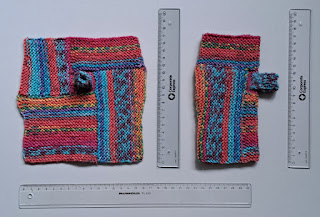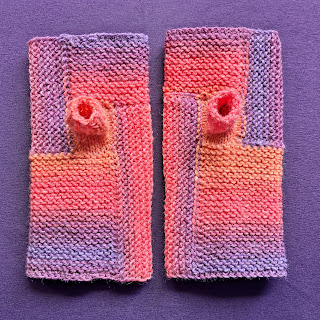Some designs take a million tries to get them right (e.g. the Partly Biased Fingerless Gloves I published earlier this year) and others just work at once. This design is of the latter category. I had the idea, drew a picture, tried it and voilà - it worked.
These fingerless gloves are knitted flat and in garter stitch stripes. They start with a provisional CO, is worked in short rows around the thumb and closed by grafting. The combination of stripes and short rows results in a striking geometrical pattern.
Since these mitts are worked with two colours and at times with very short short rows it can be quite fiddly. It is NOT a beginner pattern.
The knitting pattern is available via
The pattern PDF is 13 pages long and contains:
- written row-by-row instructions for knitting a mitt in one size only – including eight in-process photos
- a full chart
- short photo tutorials for the following techniques
- provisional CO with a crochet hook and how to undo it
- grafting in garter stitch
- short rows with wrap and turn and picking up the wraps and an explanation on doubly wrapped stitches
- weaving in yarn while carrying it (backwards and forwards)
- crochet CO
To knit these mitts you need the following materials:
- fingering weight yarn in two colors – I used a total about 35 to 40 grams: I used two (semi-)solid colored yarns with a good contrast (about 16 to 20 grams per color)
- 2.5 mm or 3 mm knitting needles (or another needle that gives you the gauge) – straight or circulars
- a crochet hook (about 3mm) and scrap yarn for the provisional CO and for the crochet CO
- 2 stitch markers
- a tapestry needle for grafting and to weave in ends
- With 2.5 mm needles 28 ridges (56 garter stitch rows) gave me 10 cm in height and 26 sts gave 10 cm in width (unblocked, since I didn't block the mitts). The finished piece is about 17 cm high (at it's highest point) and about 16 cm in diameter (without just below the thumb).
- With 3 mm needles 25 ridges (50 garter stitch rows) gave me 10 cm in height and 24 sts gave 10 cm in width (also unblocked). The finished piece measures about 19 cm in height and about 18 cm in diameter (just below the thumb).
























